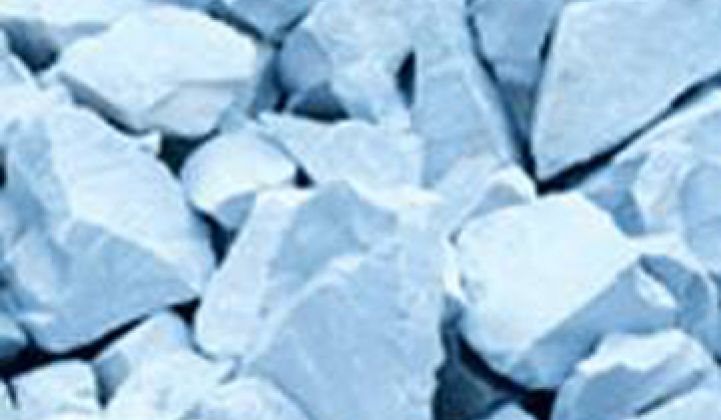Is the lithium industry about to see the same sort of titanic price hikes that have plagued the market for rare earth elements?
In a word, no, says Peter Oliver, the CEO of Talison Lithium LTD., the largest lithium miner in the world with a 30 percent global market share.
But the world could see significant price increases in the future. Over the next decade, projected supply will barely be able to keep up with the rapidly increasing demand from existing markets like consumer electronics and pharmaceuticals, he noted.
If electric vehicles take off faster than expected, or if China restricts exports on the 16 percent of global lithium reserves it controls, prices could spike.
Lithium carbonate -- a semi-refined material from lithium ores that subsequently gets converted into the salts and metallic powders added to batteries and ceramics -- now sells for around $5,000 a ton. Two competitors just raised their ore prices by 20 percent. Partly as a result, the new “normal” price could become $6,000 a ton in the relatively near future.
“Even without EVs, you’re still looking at a market that will grow 2.5 times in the next ten years,” he said during a meeting in San Francisco. “It’s like iron ore.”
Welcome to the world of raw materials, where economics and business planning have to be adapted to handle unforeseen events and political upheavals. Lithium, the third element on the periodic table, isn’t rare per se. It doesn’t even sell for very much. A $15,000 EV battery might only contain $100 worth of lithium, Oliver said.
“The cost of the battery is all in the electronics,” he said.
What are rare are deposits with rich ores that allow companies to mine it profitably. Luckily for the company, Talison’s Greenbushes mine in Western Australia turns out to possess large quantities of some of the highest quality ores in the world. Talison has mined lithium from it for 25 years and the mine has 22 years' worth of reserves left.
The mine alone has allowed the company to grab a 30 percent global share and an 80 percent share in China. In fact, all of its current output goes to China. Talison currently extracts 350,000 tons of lithium ores out of the mine a year, which gets reduced to 50,000 tons of lithium carbonate. By the middle of next year, it will expand capacity to 110,000 tons. Talison will see a 32 percent increase in sales this year.
Only a few other large competitors like FMC and Chemtall exist. In all, Talison and three of its nearest competitors control about 84 percent of the world output, with China controlling most of the rest. A number of “juniors” -- smaller miners -- exist worldwide, but often they sit on less rich, more speculative deposits. (Editor's note: In the U.S., for instance, Simbol Mining hopes to extract lithium from geothermal wells, skirting the mine in mining all together.)
Some juniors claim they could -- with the right technology and investment -- prepare lithium carbonate for $1,500 a ton. But considering the majors produce it for $2,000 to $3,000 a ton with richer ores, the claims of the juniors can be discounted, he said. Some of these more speculative sites might someday become profitable, but lithium carbonate would have to rise to $10,000 or more a ton. Lithium recycling in electronics is somewhat limited -- only around 1 percent gets recovered now -- but it will likely not impact mining prices, he added.
“Economic lithium is not that common,” he said. “There is plenty of lithium. It is all about cost.”
Still, even with a de facto oligopoly, life is not easy for the majors. It takes approximately three to five years of planning and construction to expand operations or open up new sources of minerals. Between the initial investment and the time the actual mining operations commence, prices can plummet. In a sense, it’s like the memory chip business: companies must wager billions of dollars and then hope the new facility opens its doors before the boom ends.
Right now, the world consumes around 150,000 tons of lithium carbonate a year and produces about that much. By 2015, production might rise to 222,000 tons with demand coming in between 222,000 to 226,000 tons, according to one of Talison's bar charts. By 2020, supply will be around 350,000 tons with demand ranging from around that level to over 500,000 tons. It’s a huge opportunity, but under- or over-anticipating demand at any time during the cycle could result in some serious financial headaches.
So how will Talison insulate itself from the unpredictable? Besides expanding Greenbushes to the 110,000 tons per year level, the company also expects to open a minerals conversion plant for producing carbonate by 2015.
The lithium carbonates from this plant will go to customers in Japan and South Korea. Last year, Japan got a shock when China announced it would curb exports, particularly to Japan.
“Security of supply is probably more important than absolute cost,” he said.
Then, in 2016, the company hopes to start extracting lithium and potassium from brine deposits in Chile’s Atacama Desert. The cost of extracting lithium from brines versus mining it is less of an issue than the quality of the ore.
“It is all about the grade,” he said.
Chile places additional restrictions on a few natural resources like lithium and uranium, but Talison does not anticipate any unusual requirements. Bolivia, by contrast, wants mining companies to locate car plants nearby.



